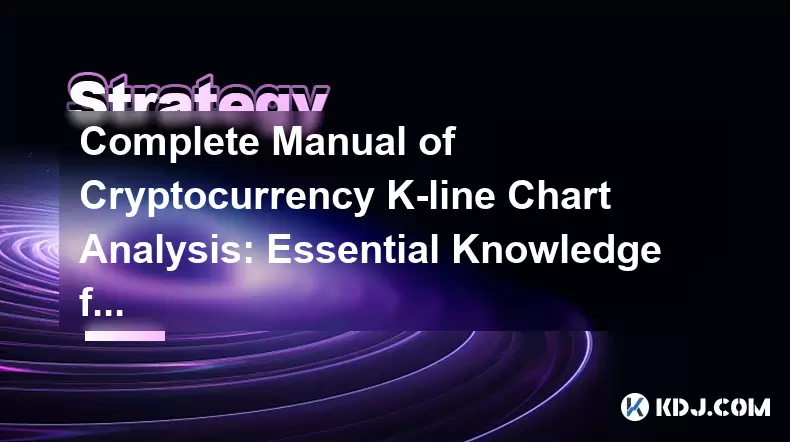-
 bitcoin
bitcoin $123963.239194 USD
1.37% -
 ethereum
ethereum $4529.082464 USD
1.07% -
 xrp
xrp $2.983640 USD
0.71% -
 tether
tether $1.000287 USD
0.02% -
 bnb
bnb $1179.874393 USD
2.99% -
 solana
solana $230.633678 USD
1.55% -
 usd-coin
usd-coin $0.999835 USD
0.03% -
 dogecoin
dogecoin $0.254240 USD
1.34% -
 tron
tron $0.341176 USD
0.15% -
 cardano
cardano $0.842285 USD
0.52% -
 hyperliquid
hyperliquid $48.537896 USD
-0.86% -
 chainlink
chainlink $21.863092 USD
-0.84% -
 ethena-usde
ethena-usde $0.999743 USD
-0.07% -
 sui
sui $3.579561 USD
-0.18% -
 stellar
stellar $0.403418 USD
2.67%
Complete Manual of Cryptocurrency K-line Chart Analysis: Essential Knowledge from Novice to Expert
K-line charts reveal crypto price trends through candlestick patterns like doji, hammers, and engulfing signals, helping traders spot reversals and market sentiment.
Jun 17, 2025 at 10:49 pm

Understanding the Basics of K-line Charts
K-line charts, also known as candlestick charts, are essential tools for analyzing price movements in cryptocurrency markets. Each K-line represents a specific time interval and displays four key data points: open, high, low, and close prices. These candles can be either bullish (green or white) when the closing price is higher than the opening price or bearish (red or black) when the opposite occurs.
The body of the candlestick shows the range between the open and close, while the wicks or shadows indicate the highest and lowest prices reached during that period. Understanding how to read these visual cues helps traders make informed decisions based on historical price behavior.
It’s important to note that different timeframes—such as 1-minute, 1-hour, or daily charts—can reveal varying levels of detail, which means selecting the appropriate timeframe is crucial depending on your trading strategy.
Identifying Common K-line Patterns
There are numerous candlestick patterns that traders use to predict future price movements. Some of the most common include:
- Doji: This pattern forms when the open and close prices are nearly equal, indicating market indecision.
- Hammer and Hanging Man: Both have small bodies with long lower wicks. A hammer suggests a potential reversal from a downtrend, whereas a hanging man may signal a top reversal.
- Engulfing Pattern: When a large candle completely engulfs the previous candle's range, it often signals a strong shift in momentum.
- Shooting Star and Inverted Hammer: These appear similar but differ in context. A shooting star appears at the top of an uptrend and suggests a reversal, while an inverted hammer occurs during a downtrend.
Recognizing these patterns allows traders to anticipate potential trend reversals or continuations, improving their timing for entries and exits.
Reading Market Sentiment Through K-line Behavior
Beyond individual patterns, the overall structure and sequence of K-lines can reflect broader market sentiment. For example, a series of bullish candles with minimal upper wicks may suggest strong buying pressure, while frequent long upper wicks might indicate resistance zones where selling pressure kicks in.
Volume plays a critical role in confirming K-line signals. If a bullish engulfing pattern appears alongside a surge in volume, it strengthens the likelihood of a genuine trend reversal. Conversely, if such a pattern forms on low volume, it may not carry much weight.
Traders should also observe how price reacts near key support and resistance levels, as K-line formations around these areas tend to be more reliable indicators.
Combining K-line Analysis with Technical Indicators
While K-line charts offer valuable insights, they work best when used in conjunction with other technical tools. Popular indicators include:
- Moving Averages (MA): Help smooth out price data to identify trends more clearly.
- Relative Strength Index (RSI): Measures overbought or oversold conditions, which can validate or contradict K-line signals.
- Bollinger Bands: Show volatility and potential breakout points, especially useful when paired with candlestick breakouts.
For instance, a bullish hammer forming at the lower Bollinger Band combined with an RSI reading below 30 could indicate a strong buying opportunity, supported by both candlestick and oscillator analysis.
It’s also vital to avoid overloading charts with too many indicators, which can lead to confusion and contradictory signals. Focus on a few complementary tools that align with your trading style.
Practical Steps to Analyze Cryptocurrency K-line Charts
To begin analyzing K-line charts effectively, follow these steps:
- Choose a reliable charting platform like TradingView or Binance’s native tools.
- Select the appropriate cryptocurrency pair and timeframe based on your trading goals.
- Mark key support and resistance levels manually or using horizontal lines and trendlines.
- Identify recent candlestick patterns and assess whether they align with current market conditions.
- Cross-reference with volume and other indicators to confirm the strength of the signal.
- Set realistic entry, exit, and stop-loss levels based on candle behavior and nearby volatility.
Consistent practice and journaling of past trades help reinforce learning and refine strategies, making K-line analysis a powerful skill over time.
Common Mistakes to Avoid in K-line Chart Reading
Even experienced traders sometimes fall into pitfalls when interpreting K-line charts. One major error is relying solely on candlestick patterns without considering the broader market context. A bullish engulfing pattern in a strong downtrend may not necessarily reverse the trend unless accompanied by fundamental or macroeconomic shifts.
Another mistake is ignoring the importance of candle location. A hammer forming at a key support level is far more meaningful than one appearing in the middle of a sideways consolidation.
Lastly, trading every single pattern without filtering for quality setups leads to unnecessary losses. It’s better to wait for high-probability scenarios that align with your strategy rather than chasing every signal.
Frequently Asked Questions
What timeframes are best for K-line chart analysis in crypto trading?The optimal timeframe depends on your trading strategy. Day traders often rely on 5-minute to 1-hour charts, while swing traders prefer 4-hour to daily charts. Long-term investors may focus on weekly or monthly charts for broader trend confirmation.
How do I distinguish between real and fake K-line patterns?Real patterns typically form near significant support/resistance levels and are confirmed by volume and other indicators. Fake patterns often occur in low-volume environments or within tight ranges, lacking clear directional commitment from the market.
Can K-line analysis be applied to all cryptocurrencies?Yes, K-line analysis applies universally across all tradable assets, including cryptocurrencies. However, less liquid altcoins may produce misleading patterns due to erratic price swings and thin order books, so caution is advised.
Is it possible to trade profitably using only K-line charts?While some traders succeed using pure price action strategies, combining K-line analysis with volume and trend indicators significantly increases accuracy. Sole reliance on candlesticks without additional filters can result in false signals and emotional trading.
Disclaimer:info@kdj.com
The information provided is not trading advice. kdj.com does not assume any responsibility for any investments made based on the information provided in this article. Cryptocurrencies are highly volatile and it is highly recommended that you invest with caution after thorough research!
If you believe that the content used on this website infringes your copyright, please contact us immediately (info@kdj.com) and we will delete it promptly.
- BlockDAG, DOGE, HYPE Sponsorship: Crypto Trends Shaping 2025
- 2025-10-01 00:25:13
- Deutsche Börse and Circle: A StableCoin Adoption Powerhouse in Europe
- 2025-10-01 00:25:13
- BlockDAG's Presale Buzz: Is It the Crypto to Watch in October 2025?
- 2025-10-01 00:30:13
- Bitcoin, Crypto, and IQ: When Genius Meets Digital Gold?
- 2025-10-01 00:30:13
- Stablecoins, American Innovation, and Wallet Tokens: The Next Frontier
- 2025-10-01 00:35:12
- NBU, Coins, and Crypto in Ukraine: A New Yorker's Take
- 2025-10-01 00:45:14
Related knowledge

Practical parameter settings for a Bitcoin multi-timeframe moving average system
Sep 18,2025 at 10:54pm
Optimizing Timeframe Combinations for Bitcoin Trading1. Selecting appropriate timeframes is crucial when building a multi-timeframe moving average sys...

How can I filter out false breakouts in Dogecoin high-frequency trading?
Sep 22,2025 at 01:00am
Understanding False Breakouts in Dogecoin Trading1. A false breakout occurs when Dogecoin's price appears to move beyond a defined support or resistan...

Techniques for identifying tops and bottoms in the Bitcoin on-chain NVT model
Sep 20,2025 at 07:54pm
Understanding the NVT Model in Bitcoin Analysis1. The Network Value to Transactions (NVT) ratio is often described as the 'P/E ratio' of the cryptocur...

What does the surge in open interest in Bitcoincoin futures mean?
Sep 20,2025 at 11:18pm
Understanding the Surge in Dogecoin Futures Open Interest1. A surge in open interest within Dogecoin futures indicates a growing number of active cont...

How can I use the Ethereum USDT premium to gauge market sentiment?
Sep 18,2025 at 11:55pm
Understanding the Ethereum USDT Premium1. The Ethereum USDT premium refers to the price difference between USDT (Tether) traded on Ethereum-based plat...

What should I do if Ethereum staking yields decline?
Sep 20,2025 at 06:18am
Understanding the Causes Behind Declining Ethereum Staking Yields1. The Ethereum network transitioned to a proof-of-stake consensus mechanism with the...

Practical parameter settings for a Bitcoin multi-timeframe moving average system
Sep 18,2025 at 10:54pm
Optimizing Timeframe Combinations for Bitcoin Trading1. Selecting appropriate timeframes is crucial when building a multi-timeframe moving average sys...

How can I filter out false breakouts in Dogecoin high-frequency trading?
Sep 22,2025 at 01:00am
Understanding False Breakouts in Dogecoin Trading1. A false breakout occurs when Dogecoin's price appears to move beyond a defined support or resistan...

Techniques for identifying tops and bottoms in the Bitcoin on-chain NVT model
Sep 20,2025 at 07:54pm
Understanding the NVT Model in Bitcoin Analysis1. The Network Value to Transactions (NVT) ratio is often described as the 'P/E ratio' of the cryptocur...

What does the surge in open interest in Bitcoincoin futures mean?
Sep 20,2025 at 11:18pm
Understanding the Surge in Dogecoin Futures Open Interest1. A surge in open interest within Dogecoin futures indicates a growing number of active cont...

How can I use the Ethereum USDT premium to gauge market sentiment?
Sep 18,2025 at 11:55pm
Understanding the Ethereum USDT Premium1. The Ethereum USDT premium refers to the price difference between USDT (Tether) traded on Ethereum-based plat...

What should I do if Ethereum staking yields decline?
Sep 20,2025 at 06:18am
Understanding the Causes Behind Declining Ethereum Staking Yields1. The Ethereum network transitioned to a proof-of-stake consensus mechanism with the...
See all articles










































































